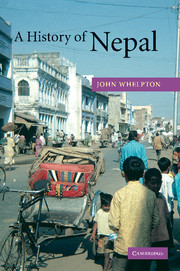Book contents
- Frontmatter
- Contents
- List of illustrations
- List of maps
- List of tables
- Key events
- Acknowledgements
- Notes on romanisation and terminology
- List of abbreviations
- Introduction
- 1 Environment, state and society in the central Himalayas to 1743
- 2 Unification and sanskritisation, 1743 – 1885
- 3 Nepal under the Shamsher Ranas, 1885 – 1951
- 4 The monarchy in ascendance: domestic politics and foreign relations, 1951 – 1991
- 5 The quest for ‘development’: economy and environment, 1951 – 1991
- 6 Lifestyles, values, identities: changes in Nepalese society, 1951 – 1991
- 7 Democracy and disillusionment: Nepal since 1991
- Genealogical tables
- Biographical notes
- Notes
- Glossary
- Bibliography
- Index
- Frontmatter
- Contents
- List of illustrations
- List of maps
- List of tables
- Key events
- Acknowledgements
- Notes on romanisation and terminology
- List of abbreviations
- Introduction
- 1 Environment, state and society in the central Himalayas to 1743
- 2 Unification and sanskritisation, 1743 – 1885
- 3 Nepal under the Shamsher Ranas, 1885 – 1951
- 4 The monarchy in ascendance: domestic politics and foreign relations, 1951 – 1991
- 5 The quest for ‘development’: economy and environment, 1951 – 1991
- 6 Lifestyles, values, identities: changes in Nepalese society, 1951 – 1991
- 7 Democracy and disillusionment: Nepal since 1991
- Genealogical tables
- Biographical notes
- Notes
- Glossary
- Bibliography
- Index
Summary
Despite its geo-strategically important position in the Himalayas between India and China and its popularity as an exotic tourist destination, Nepal has not normally loomed large in the consciousness of the average educated person in the English-speaking world. This changes briefly when the spotlight of media attention falls on the country, as during the ‘People's Movement’ for democracy in 1990 or with the massacre of the royal family and the intensification of the Maoist insurgency in 2001. Sudden and violent political change has indeed been a recurrent part of the country's history but should not distract attention from less dramatic, long-term processes affecting conditions of life for the majority of its people. These remain even today primarily dependent on subsistence agriculture, though they also rely increasingly on supplementary income from other activities.
Nepal as a state emerged in its present form only in the late eighteenth century when the small hill kingdom of Gorkha, some fifty miles west of Kathmandu, brought much of the Himalayan foothills and an adjoining strip of the North Indian plain under its control, and the kingdom's Shah dynasty moved its court to the Kathmandu Valley. From 1846 to 1951, though the Shahs remained on the throne, effective political power was in the hands of the Rana family, who as hereditary prime ministers were in a roughly analogous position to the Japanese shoguns before the Meiji restoration. The Rana system was eventually brought down by an alliance between the monarchy and modernising intellectuals, with decisive backing from newly independent India, and a policy of seclusion from the outside world that the country had followed throughout most of its modern history was finally abandoned. After experiments with parliamentary democracy in the 1950s, party politics were banned and power centralised in the royal palace from 1960 until the mass protests of 1990 brought about a return to the multi-party system and rule by elected governments. However, the failure of the new system to provide stable government at the centre was compounded by the growth of ‘Maoist’ insurgency from 1996 onwards, and deep-seated economic and social problems remain to be solved.
In order to understand a country's present, what matters is often not just the past as such, but rather the way in which that past is now understood and interpreted.
- Type
- Chapter
- Information
- A History of Nepal , pp. 1 - 5Publisher: Cambridge University PressPrint publication year: 2005



